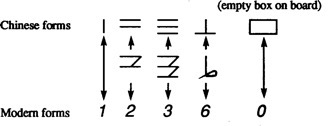- About MAA
- Membership
- MAA Publications
- Periodicals
- Blogs
- MAA Book Series
- MAA Press (an imprint of the AMS)
- MAA Notes
- MAA Reviews
- Mathematical Communication
- Information for Libraries
- Author Resources
- Advertise with MAA
- Meetings
- Competitions
- Programs
- Communities
- MAA Sections
- SIGMAA
- MAA Connect
- Students
- MAA Awards
- Awards Booklets
- Writing Awards
- Teaching Awards
- Service Awards
- Research Awards
- Lecture Awards
- Putnam Competition Individual and Team Winners
- D. E. Shaw Group AMC 8 Awards & Certificates
- Maryam Mirzakhani AMC 10 A Awards & Certificates
- Two Sigma AMC 10 B Awards & Certificates
- Jane Street AMC 12 A Awards & Certificates
- Akamai AMC 12 B Awards & Certificates
- High School Teachers
- News
You are here
Reflections on Chinese Numeration Systems: What If?
If a bundle of sticks had such a prolonged and productive involvement with mathematics, then where do we see evidence of their existence today? The traditional written characters used to express some numbers in China and Japan bear vestiges of their heritage in counting rods. Specifically, Ei ,er, and san, the first three counting numbers, provide evidence of rod origins:

Figure 11. Characters for the numbers \(1\), \(2\), and \(3\). Figure drawn by the author.
Further, and perhaps more interesting, is the conjecture by historians of mathematics such as Wang Ling, Joseph Needham, and Lam Lay Yong and Ang Tian Se that our contemporary numeral system is derived from rod placements [Xu 2005]. They suggest that, as rod numerals were recorded and copied over centuries, scribes became complacent and hastened their writing process, gradually slipping into more cursive forms as illustrated below.

Figure 12. A conjectured evolution of numeration systems. Figure drawn by the author.
What do you think? Perhaps our numeral system could more correctly be designated as the ‘Sino–Hindu–Arabic’ numeral system. Such a title might be more encompassing and historically revealing.
Frank J. Swetz (The Pennsylvania State University), "Reflections on Chinese Numeration Systems: What If?," Convergence (February 2022)




